
North Hartland Bridge Building: 2001
[WGN 45-14-64#2]

North Hartland Bridge Building Index
- North Hartland Covered Bridge Soon To Replace Concrete Span: August 2001
- North Hartland Covered Bridge Update: Construction Photos
- North Hartland Covered Bridge Replaces Concrete Span: October 2001
- North Hartland Covered Bridge Opening: October 13, 2001
North Hartland Covered Bridge Soon To Replace Concrete Span: August 2001
August 15, 2001
Man bites dog! A steel and concrete bridge is being replaced by a wooden covered bridge instead of the other way around! Jan Lewandoski of Restoration and Traditional Building is the contractor.
Two bridges crossed the Ottauquechee River at the North Hartland Dam, mainland to island, island to mainland. The concrete bridge has failed, but the Willard Covered Bridge is in great shape, said Lewandoski. "The Willard Bridge, better than most, it's taller, 16 feet from the bottom of the bottom to the top of the top, it has positive camber, it's about 118 feet long."
Two covered bridges served the causeway until a hurricane took one of the bridges out in 1938. "They replaced it with a concrete bridge," said covered bridge restorer Lewandoski.
"The town has decided they want to put a wooden bridge back in there, and the State went along with that. And because one wooden bridge already exists, there is no point in making the other wooden bridge any wider or taller than that one, so I didn't have to build 24 feet of roadway or something like that, just 17 feet of roadway like the existing one has. It does you no good to get into the one bridge if you can't get through the other one."
Asked for the name of the new bridge, Lewandoski replied: "The bridge has no particular name although they were known as the twin bridges. The existing bridge is sometimes called the Willard Bridge after a prominent family in North Hartland.
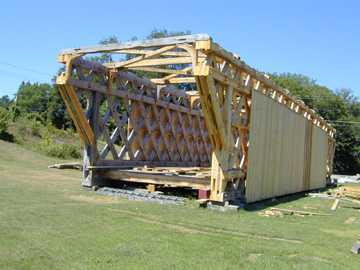
Photo by Joe Nelson
August 15, 2001
The new 88-foot Town Truss bridge stands in a field near the Ottauquechee Dam.
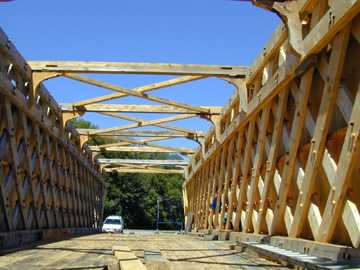
Photo by Joe Nelson
August 15, 2001
Note the use of ship's knees as bracing. These pieces where cut from tree stumps to make use of the naturally curving grain.
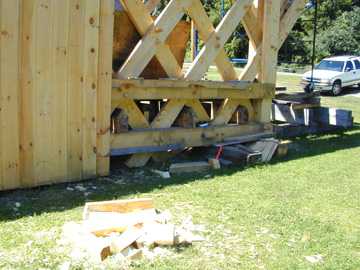
Photo by Joe Nelson
August 15, 2001
Note that the floor beam ends have been shaped to fit through the lattice.
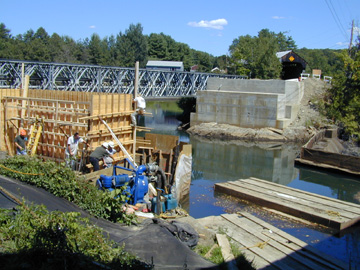
Photo by Joe Nelson
August 15, 2001
The abutments are under construction, one being poured, the other curing.
North Hartland Bridge Update: Construction Photos 2001
Photographer Tom Chase is the VTrans Resident Engineer on the North Hartland covered bridge project
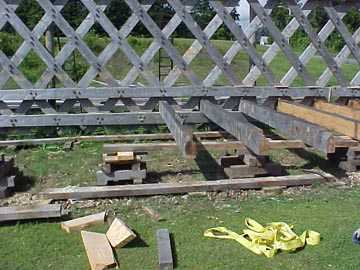
Photo by Tom Chase
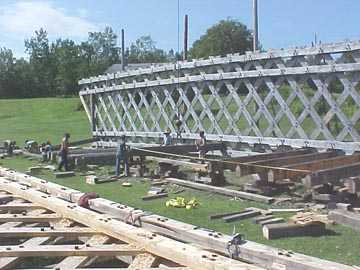
Photo by Tom Chase
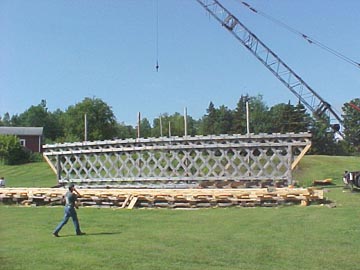
Photo by Tom Chase
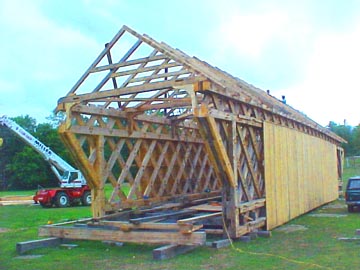
Photo by Tom Chase
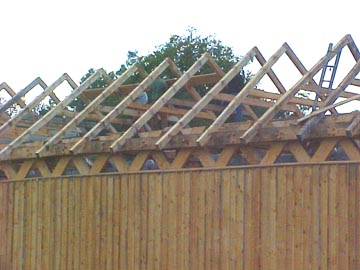
Photo by Tom Chase
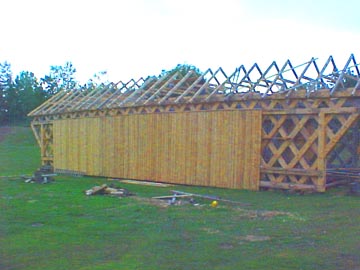
Photo by Tom Chase
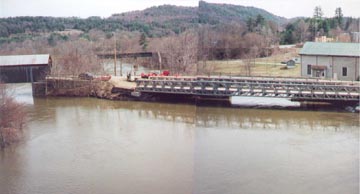
Photo by Tom Chase
View of the Willard Bridge and the causeway from the bridge on I91
North Hartland Covered Bridge Replaces Concrete Span: October 2001
On this day the first covered bridge in Vermont built to replace a failing concrete and steel span was moved into place. The new bridge, constructed by Jan Lewandoski's Restoration and Traditional Building company, was moved from the nearby recreation field where it was assembled to its place on the causeway of the North Hartland Dam. For the first time since the hurricane of 1938, the Willard Covered Bridge has an as yet unnamed wooden twin.
The official opening ceremony for the New North Hartland Bridge is to take place 11:00 a.m., Saturday, October 13, 2001, however, according to Tom Close, VAOT resident engineer, traffic has been traveling through the structure during non-working hours since Friday afternoon, October 5.
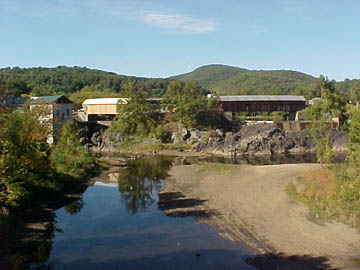
Photo by Tom Chase
October 9, 2001
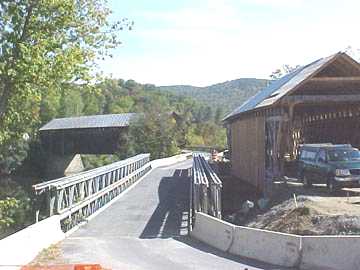
Photo by Tom Chase
October 9, 2001
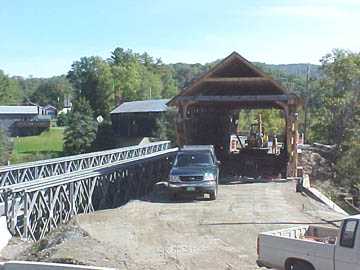
Photo by Tom Chase
October 9, 2001
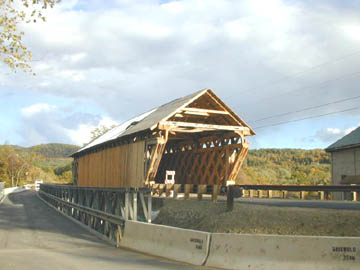
Photo by Jim Smedley
October 10, 2001
North Hartland Celebrates Bridge Opening!
North Hartland - Saturday, October 13, 2001
The as yet unnamed new covered bridge was officially opened to traffic after the ceremony. Nearly one-hundred spectators, mostly townspeople attended.
The new bridge joins the Willard Bridge in spanning the Ottauquechee River Dam causeway restoring the twosome interrupted by the 1938 hurricane. The lost covered bridge was replaced by a concrete and steel span. The two covered bridges are referred to as the North Hartland twin bridges.
Warren Tripp, retired chief of VAOT Structures was one of six who addressed the gathering. Mr. Tripp was in charge when the issue of repairing or replacing the causeway concrete bridge came up. Some of his remarks, paraphrased:
This bridge adds one to the number of covered bridges in Vermont--it is the only new covered bridge to replace a bridge of another type. In 1994, Tripp said, the Agency and the Town signed an agreement to repair the old bridge. In 1995, the Town asked why not replace the bridge with a covered bridge? The VAOT agreed that it could fund part of the cost of the covered bridge. The Town contacted Jan Lewandoski for the bridge and the State contracted for the abutments and the temporary bridge.
The new bridge uses the Town truss and is similar in construction to the Willard Bridge, which was built in 1919¹. Jan Lewandoski remarked that the trusses in his bridge are 16 feet high from bottom to top, v.s. the State's average 14 feet. He also noted that 16 of the 18 ship's knees used to brace the trusses were cut from the stumps of tamarack trees--two were cut from spruce. The bridge features a camber of seven inches, the truss members are 3" x 11" spruce timbers secured with 700 treenails, and the deck is constructed of oak and hickory.
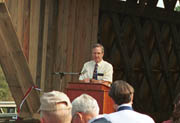
Photo by Joe Nelson
October 13, 2001
Robert Stacey, Town Manager
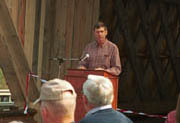
Photo by Joe Nelson
October 13, 2001
Gordon Richardson, Legislature
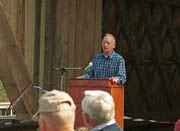
Photo by Joe Nelson
October 13, 2001
Warren Tripp, VAOT retired
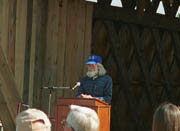
Photo by Joe Nelson
October 13, 2001
Hiram (?), former town manager
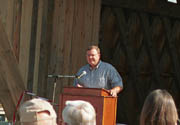
Photo by Joe Nelson
October 13, 2001
William Patnode, Alpine Construction, builder of the abutments
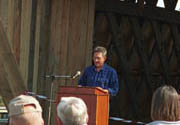
Photo by Joe Nelson
October 13, 2001
Jan Lewandoski, Restoration and Traditional Building, Inc., builder of the bridge.
Addressing the gathering are: Robert Stacey, Town Manager; Gordon Richardson, Legislature; Warren Tripp, VAOT retired; Hiram (?), former town manager; William Patnode, Alpine Construction, builder of the abutments; Jan Lewandoski, Restoration and Traditional Building, Inc., builder of the bridge.
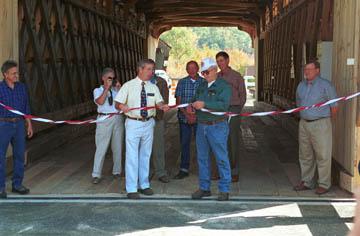
Photo by Joe Nelson
October 13, 2001
John Bowley cuts the ribbon.
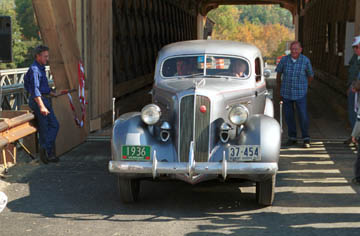
Photo by Joe Nelson
October 13, 2001
The first car to officially cross the bridge is Bruce Dowd's 1936 Studebaker.
